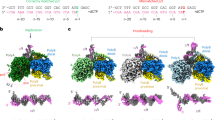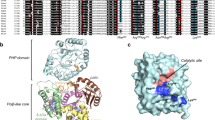Abstract
5′ nucleotidases are ubiquitous enzymes that dephosphorylate nucleoside monophosphates and participate in the regulation of nucleotide pools. The mitochondrial 5′-(3′) deoxyribonucleotidase (dNT-2) specifically dephosphorylates dUMP and dTMP, thereby protecting mitochondrial DNA replication from excess dTTP. We have solved the structure of dNT-2, the first of a mammalian 5′ nucleotidase. The structure reveals a relationship to the HAD family, members of which use an aspartyl nucleophile as their common catalytic strategy, with a phosphoserine phosphatase as the most similar neighbor. A structure-based sequence alignment of dNT-2 with other 5′ nucleotidases also suggests a common origin for these enzymes. Here we study the structures of dNT-2 in complex with bound phosphate and beryllium trifluoride plus thymidine as model for a phosphoenzyme–product complex. Based on these structures, determinants for substrate specificity recognition and the catalytic action of dNT-2 are outlined.
This is a preview of subscription content, access via your institution
Access options
Subscribe to this journal
Receive 12 print issues and online access
$189.00 per year
only $15.75 per issue
Buy this article
- Purchase on Springer Link
- Instant access to full article PDF
Prices may be subject to local taxes which are calculated during checkout





Similar content being viewed by others
Accession codes
References
Reichard, P. Interactions between deoxyribonucleotide and DNA synthesis. Annu. Rev. Biochem. 57, 349–374 (1988).
Johansson, M. & Karlsson, A. Cloning and expression of human deoxyguanosine kinase cDNA. Proc. Natl. Acad. Sci. USA 93, 7258–7262 (1996).
Johansson, M. & Karlsson, A. Cloning of the cDNA and chromosome localization of the gene for human thymidine kinase 2. J. Biol. Chem. 272, 8454–8458 (1997).
Mandel, H. et al. The deoxyguanosine kinase gene is mutated in individuals with depleted hepatocerebral mitochondrial DNA. Nature Genet. 29, 337–331 (2001).
Saada, A. et al. Mutant mitochondrial thymidine kinase in mitochondrial DNA depletion myopathy. Nature Genet. 29, 342–344 (2001).
Arpaia, E. et al. Mitochondrial basis for immune deficiency. Evidence from purine nucleoside phosphorylase-deficient mice. J. Exp. Med. 191, 2197–2208 (2000).
Nishino, I., Spinazzola, A. & Hirano, M. Thymidine phosphorylase gene mutations in MNGIE, a human mitochondrial disorder. Science 283, 689–692 (1999).
Rampazzo, C. et al. A deoxyribonucleotidase in mitochondria: involvement in regulation of dNTP pools and possible link to genetic disease. Proc. Natl. Acad. Sci. USA 97, 8239–8244 (2000).
Rampazzo, C. et al. Mammalian 5′(3′)-deoxyribonucleotidase, cDNA cloning, and overexpression of the enzyme in Escherichia coli and mammalian cells. J. Biol. Chem. 275, 5409–5415 (2000).
Gazziola, C. et al. Cytosolic high Km 5′-nucleotidase and 5′(3′)-deoxyribonucleotidase in substrate cycles involved in nucleotide metabolism. J. Biol. Chem. 276, 6185–6190 (2001).
Lewis, W. & Dalakas, M.C. Mitochondrial toxicity of antiviral drugs. Nature Med. 1, 417–422 (1995).
Resta, R., Yamashita, Y. & Thompson, L.F. Ecto-enzyme and signaling functions of lymphocyte CD73. Immunol. Rev. 161, 95–109 (1998).
Itoh, R. IMP-GMP 5′-nucleotidase. Comp. Biochem. Physiol. B 105, 13–19 (1993).
Hunsucker, S.A., Spychala, J. & Mitchell, B.S. Human cytosolic 5′-nucleotidase I: characterization and role in nucleoside analog resistance. J. Biol. Chem. 276, 10498–10504 (2001).
Sala-Newby, G.B. & Newby, A.C. Cloning of a mouse cytosolic 5′-nucleotidase-I identifies a new gene related to human autoimmune infertility-related protein. Biochim. Biophys. Acta. 1521, 12–18 (2001).
Paglia, D.E. et al. Pyrimidine nucleotidase deficiency with active dephosphorylation of dTMP: evidence for existence of thymidine nucleotidase in human erythrocytes. Blood 62, 1147–1149 (1983).
Knofel, T. & Strater, N. X-ray structure of the Escherichia coli periplasmic 5′-nucleotidase containing a dimetal catalytic site. Nature Struct. Biol. 6, 448–453 (1999).
Barford, D., Das, A.K. & Egloff M.P. The structure and mechanism of protein phosphatases: insights into catalysis and regulation. Annu. Rev. Biophys. Biomol. Struct. 27, 133–164 (1998).
Amici, A. et al. Pyrimidine nucleotidases from human erythrocyte possess phosphotransferase activities specific for pyrimidine nucleotides. FEBS Lett. 419, 263–267 (1997).
Amici, A. et al. Pyrimidine nucleotidases/phosphotransferases from human erythrocyte. Nucleosides Nucleotides 18, 853–855 (1999).
Allegrini, S. et al. Bovine cytosolic 5′-nucleotidase acts through the formation of an aspartate 52-phosphoenzyme intermediate. J. Biol. Chem. 276, 33526–33532 (2001).
Wang, W. et al. Crystal structure of phosphoserine phosphatase from Methanococcus jannaschii, a hyperthermophile, at 1.8 Å resolution. Structure (Camb) 9, 65–71 (2001).
Collet, J.F. et al. A new class of phosphotransferases phosphorylated on an aspartate residue in an amino-terminal DXDX(T/V) motif. J. Biol. Chem. 273, 14107–14112 (1998).
Hendrickson, W.A. Phase determination from multiwavelength anomalous diffraction measurements. Methods Enzymol. 276, 494–523 (1997).
Holm, L. & Sander, C. Searching protein structure databases has come of age. Proteins 19, 165–173 (1994).
Ridder, I.S. et al. Three-dimensional structure of L-2-haloacid dehalogenase from Xanthobacter autotrophicus GJ10 complexed with the substrate-analogue formate. J. Biol. Chem. 272, 33015–33022 (1997).
Morais, M.C. et al. The crystal structure of Bacillus cereus phosphonoacetaldehyde hydrolase: insight into catalysis of phosphorus bond cleavage and catalytic diversification within the HAD enzyme superfamily. Biochemistry, 39, 10385–10396 (2000).
Lee, S.Y. et al. Crystal structure of activated CheY. Comparison with other activated receiver domains. J. Biol. Chem. 276, 16425–16431 (2001).
Cho, H. et al. BeF3(-) acts as a phosphate analog in proteins phosphorylated on aspartate: structure of a BeF3(-) complex with phosphoserine phosphatase. Proc. Natl. Acad. Sci. USA 98, 8525–8230 (2001).
Toyoshima, C. et al. Crystal structure of the calcium pump of sarcoplasmic reticulum at 2.6 Å resolution. Nature 405, 647–655 (2000).
Mourey, L. et al. Crystal structure of the CheA histidine phosphotransfer domain that mediates response regulator phosphorylation in bacterial chemotaxis. J. Biol. Chem. 276, 31074–31082 (2001).
Selengut, J.D. MDP-1 is a new and distinct member of the haloacid dehalogenase family of aspartate-dependent phosphohydrolases. Biochemistry 40, 12704–12711 (2001).
Regni, C., Tipton, P.A. & Beamer, L.J. Crystal structure of PMM/PGM: an enzyme in the biosynthetic pathway of P. aeruginosa virulence factors. Structure (Camb) 10, 269–279 (2002).
Lee, S.Y. et al. Crystal structure of an activated response regulator bound to its target. Nature Struct. Biol. 8, 52–56 (2001).
Otwinowski, Z. & Minor, W. in Data collection and Processing (eds Sawyer, L., Isaacs, N.& Bailey, S.) 556–562 (SERC, Warrington, UK; 1991).
Otwinowski, Z. & Minor, W. Processing of X-ray diffraction data collected in oscillation mode. Methods Enzymol. 276, 307–326 (1997).
Terwilliger T.C. & Berendzen J. Automated MAD and MIR structure solution Acta. Crystallogr. D 55, 849–861 (1999).
Collaborative Computational Project, Number 4. The CCP4 suite: programs for protein crystallography. Acta Crystallogr. D 50, 760–763 (1994).
Cowtan, K. Joint CCP4 and ESF-EACBM Newsletter on Protein Crystallography. 31, 34–38 (1994).
Abrahams, J.P. Methods used in the structure determination of bovine mitochondrial ATPase. Acta Crystallogr. D 52, 30–42 (1996).
Lamzin, V.S. & Wilson, K.S. Automated refinement of protein models. Acta Crystallogr. D 49, 129–147 (1993).
Brünger, A.T. Crystallography & NMR system: a new software suite for macromolecular structure determination. Acta. Crystallogr. D 54, 905–921 (1998).
Barton, G.J. ALSCRIPT: a tool to format multiple sequence alignments. Protein Eng. 6, 37–40 (1993).
Kraulis, P. MOLSCRIPT: a program to produce both detailed and schematic plots of protein structures. J. Appl. Crystallogr. 24, 946–950 (1991).
Esnouf, R.M. An extensively modified version of MolScript that includes greatly enhanced coloring capabilities. J. Mol. Graph. 15, 132–134 (1997).
Wallace, A.C., Laskowski, R.A. & Thornton, J.M. LIGPLOT: a program to generate schematic diagrams of protein-ligand interactions. Protein Eng. 8, 127–134 (1995).
Acknowledgements
We thank in particular M. Bennet and X.-D. Su for advice on data collection and phasing. We also thank people at the Max Lab, Y. Cerenius for technical assistance, the staff at ESRF for technical assistance and G. Leonard for help with preliminary MAD data processing. We are grateful to K.-M. Larsson, M. Högbom and P. Stenmark for help with data collection. This work was supported by grants from Theleton Italia (V.B.), AIRC Associazione Italiana per la Ricerca sul Cancro (V.B.), the Swedish Research Council (P.N.), the Swedish Cancer Society (P.N.) and from the European community.
Author information
Authors and Affiliations
Corresponding author
Ethics declarations
Competing interests
The authors declare no competing financial interests.
Rights and permissions
About this article
Cite this article
Rinaldo-Matthis, A., Rampazzo, C., Reichard, P. et al. Crystal structure of a human mitochondrial deoxyribonucleotidase. Nat Struct Mol Biol 9, 779–787 (2002). https://doi.org/10.1038/nsb846
Received:
Accepted:
Published:
Issue Date:
DOI: https://doi.org/10.1038/nsb846
This article is cited by
-
Structure and catalytic regulation of Plasmodium falciparum IMP specific nucleotidase
Nature Communications (2020)
-
Enzymatic characterization of a thermostable phosphatase from Thermomicrobium roseum and its application for biosynthesis of fructose from maltodextrin
Applied Microbiology and Biotechnology (2019)
-
Why calcium inhibits magnesium-dependent enzyme phosphoserine phosphatase? A theoretical study
Theoretical Chemistry Accounts (2012)
-
Identification of the Nucleotidase Responsible for the AMP Hydrolysing Hyperactivity Associated with Neurological and Developmental Disorders
Neurochemical Research (2008)
-
Quantum chemical modeling of enzyme active sites and reaction mechanisms
Theoretical Chemistry Accounts (2006)



